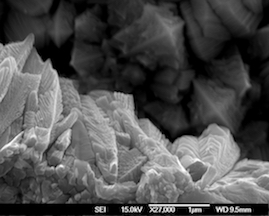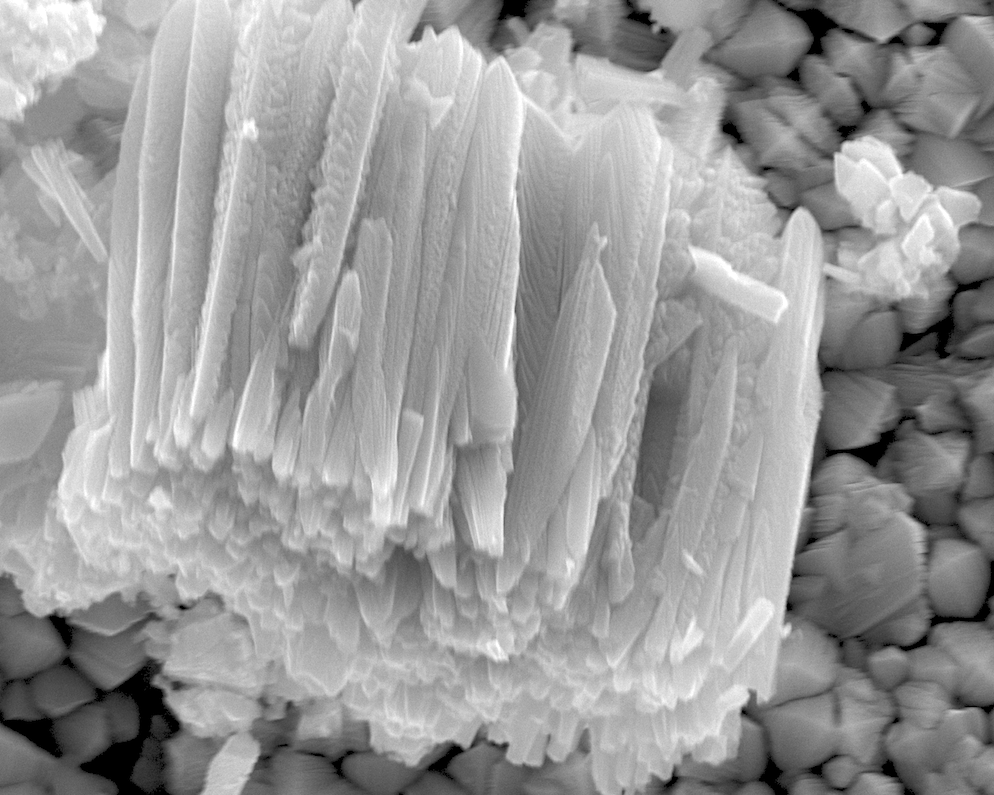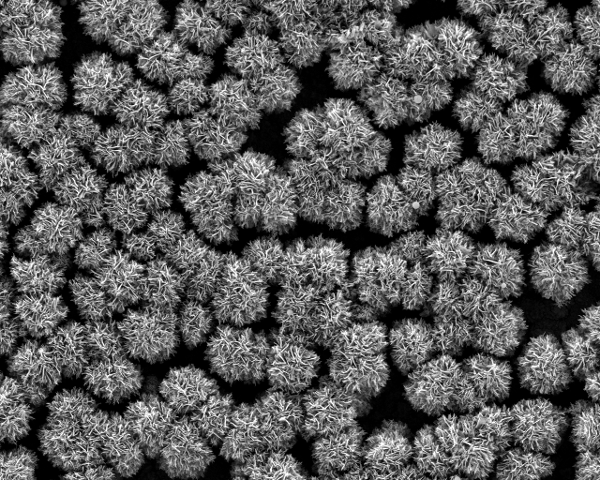Advanced Materials
Active or protective ceramic coatings on complex shaped objects. The AEMSLab has been developing a new approach to processing thin film materials and coatings that is a radical departure from conventional methods, and yet is the same. The idea arose out of the quandary of what the conventional approach could not do, yet what physics would allow. This transition of chemical vapour deposition processing is the main thrust of our research. Using the novel approach of eliminating the carrier gas and using pulsed injections to create pressure spikes, we have also developed new types of old materials that have interesting properties.
- Race to the Finish - Antimicrobial TiO2 advanced nanostructure coating on stainless steel
- Coating Process Development and Reactor Engineering
- Fundamental Science of pulsed pressure thermodynamics, mass transport and heat transfer
- New Coating Materials VIDEO
- Publication in Nature Scientific Reports revealing the novel Active BlackTM antimicrobial coating
- Commercialization - Introducing Aegis Ceramics delivering self-sterilising, hard wearing coatings

PhD Students Minni and Johann and Professor Krumdieck in the AEMSLab
A useful resource for understanding Chemical Vapor Deposition Technology and Processing has a chapter contributed by Prof. Krumdieck
Chemical Vapor Deposition: Precursors, Processes and Applications (2008), A.Jones and M. Hitchman Eds., Chapter 2 Reactors and Delivery System Technology (2008)
Race to the Finish
Pulsed-Pressure Metalorganic Chemical Vapor Deposition (PP-MOCVD )
Breakthrough research at the University of Canterbury has led to an industrially-relevant process that can apply a protective ceramic coating to metal objects - a "holy grail" of modern healthcare and advanced energy technologies. The process was invented by Professor Susan Krumdieck during her PhD thesis research in 1999 at University of Colorado, USA. It has since been developed into a platform technology with potential applications in industries such as health-care, air pollution, water purification, and electrochemical devices.
A group of students is working together on different aspects of the MBIE-funded project to develop a novel antimicrobial solid ceramic coating for hospital touch surfaces like door handles, bed rails and elevator buttons.

Race to the Finish Team 2016-2018
Sam Talwar-Davies (Koti Technologies CEO), Dr. Catherine Bishop (MECH), Prof. Jack Heinemann (BIOL), Ethan Huang, Darryl Lee (Koti Technologies), Alibe Wasa, Dr. Sarah Masters (CHEM), Rukmini Gorthy, Johann Land, Prof. Susan Krumdieck (MECH), Dr. Matt Polson (CHEM), Dr. Aleksandra Gardecka (Post-Doc).
News Article on Antimicrobials
Chemical Vapor Deposition
Chemical vapor deposition (CVD) is a high tech manufacturing process widely used in the electronics, sensors and optics industries. CVD is used to make thin layers of absolutely pure materials through what is essentially additive manufacturing at the atomic scale. CVD manufacturing is almost exclusively developed in well-funed advanced materials, chemistry and physics research labs in the USA and Europe.
Professor Krumdieck’s innovation unlocks the power of CVD for applications outside electronics by engineering a new kind of process control. The secret to the PP-MOCVD process is that it eliminates the “carrier gas” that had always been used in conventional CVD. Use of the carrier gas has limited applications to flat objects and extremely thin layers. With PP-MOCVD any shape surface can be coated with a thick and uniform ceramic layer. This is very important to industrial customers for whom wear and tear is a major contributor to cost and where a hard ceramic coating could provide significant performance benefits, improved safety or cost savings.
PP-MOCVD is a promising coating technique that affords the quality of materials and control of microstructure and composition only achieved by CVD, but with low equipment costs, and high growth rates usually only achievable with plasma spray. We are in the unique position of being able to put a ceramic coating on an ever expanding list of metal or glass products at a reasonable cost. The research group has specialisations in a range of applications that involve both international and New Zealand companies.


Industrial Research and Commercialization
Aegis Ceramics is a company at the forefront of commercialisation of the PP-MOCVD technology. There are working with the UC research group to develop new coating materials, and the optimal coating manufacturing technology for a customer’s needs. Another line of research is working with a top New Zealand manufacturer to develop the antimicrobial touch surface products.
Unique Nanostructured Anatase-Rutile-Carbon (NsARC)
The pp-MOCVD process produces unique deposition conditions which produce nanostructured, bi-phase TiO2 in a composite with carbon that has not been described previously in the scientific research literature. One area of research for the team is to understand what the material structure and composition is, why it is so much more phtoto-catalytically active than normal TiO2, and what the pp-MOCVD deposition parameters are that lead to such amazing crystal structures. The AEMSLab research team is working with Koti to capture the intellectual property around these science and engineering questions and help them to get effective and durable, but non-toxic antimicrobial coatings onto touch surfaces of hospital fittings as soon as possible.
Coverage of the novel development in ACS
Product Development Research
Anti-Microbial Coatings
Pathogens that cause hospital acquired infections (HAIs) pose an ongoing and increasing challenge, resulting in more deaths than AIDS, auto accidents and breast cancer combined in the US. The unique conditions and process control in pp-MOCVD has led to a breakthrough in solid and durable photocatalytic ceramic coatings on metal touch surfaces. The material is called “Active Black” and it has demonstrated Log4 antibacterial effectiveness against E-coli in visible light. This is at the top of antimicrobial activity reported in the scientific literature. The research team are working on a unique approach to tune the properties to inhibit bacteria colony growth, while not inducing the evolution of resistance in the pathogens. Commercial development is focusing on anti-microbial TiO2 coatings on fittings for the health-care and hospitality environments. For commercial development opportunities, contact KOTI Technologies, http://www.kotitechnologies.com/






Photocatalytic Coatings for Air Purification
The agricultural sector and in particular food preservation has a big problem that could be solved by use of the pp-MOCVD Active Black TiO2 coating. Most people have the experience of fruit suddenly ripening. If one fruit starts to ripen it produces ethylene that signals all the other fruit to ripen as well. This can result in a container load of kiwifruit worth hundreds of thousands of dollars arriving at the destination too ripe to go to market. The Active Black TiO2 can be applied onto air filters that are placed in the refrigeration system ducts and illuminated with UV LED’s to scrub out any ethylene and save the shipment. Koti are working with the Krumdieck group to develop the manufacturing process to mass produce the Active Black air purification filters.
Learn More
New Journal Articles
- Paper describing the nanostructure dimension published in Materials (2020)
- Paper revealing the nanostructure, phase and composition of the novel ActiveBlackTM antimicrobial Coating in Nature (2019)
Television Coverage
Antimicrobial Coating "discovered" by student in the AEMSLab on TVNZ News at 5 (2019) Well, it wasn't exactly an accident, but it makes a good story!
Developing high-temperature ceramic coatings to help NASA prepare for their next generation of hypersonic spacecraft ('Ever wondered?' New Zealand television series, video, 2010)
Ceramic may coat future NASA spacecraft (TVNZ interview, article and video, 2010)
Science Learning Hub website
Profile of research (article and videos)
Kiwi ingenuity and future space vehicles (article and videos)
Materials for hypersonic vehicles (video)



Tuneable Nanostructure, Phase Composition and Texture
All of the Scanning Electron Micrograph (SEM) images shown on this page are of Active Black TiO2. Some have two phases, anatase and rutile. Some are thick, and some are thin. The thickness is determined by the number of pulses used during the deposition process. Typically, thickness of 10 microns over surface area the size of a salad plate takes about an hour. The microstructure is tuneable because we can precisely control the way the precursor chemicals, the basic building blocks of the crystals, arrive at the surface. This is the unique aspect of the pulsed-pressure process. Using this control we can create very interesting nano-scale structures and composite with carbon. This is the origin of the amazing black color and the enhanced photocatalytic activity, particularly in indoor ambient visible light.














